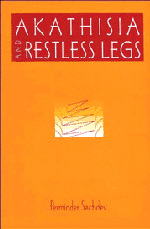Book contents
- Frontmatter
- Contents
- Foreword
- Acknowledgements
- Abbreviations
- Part I Introduction
- Part II Drug-induced akathisia
- Part III Restless legs syndrome
- Part IV Conclusions
- Appendix A Haskovec's Akathisie
- Appendix B Prince Henry Hospital Akathisia Scale
- Appendix C Barnes (1989) Akathisia Rating Scale
- Appendix D Hillside Akathisia Scale (version 4)
- References
- Index
Appendix B - Prince Henry Hospital Akathisia Scale
Published online by Cambridge University Press: 12 September 2009
- Frontmatter
- Contents
- Foreword
- Acknowledgements
- Abbreviations
- Part I Introduction
- Part II Drug-induced akathisia
- Part III Restless legs syndrome
- Part IV Conclusions
- Appendix A Haskovec's Akathisie
- Appendix B Prince Henry Hospital Akathisia Scale
- Appendix C Barnes (1989) Akathisia Rating Scale
- Appendix D Hillside Akathisia Scale (version 4)
- References
- Index
Summary
(This scale was developed by Sachdev, 1994c, based on the Braude et al, 1983, questionnaire.)
Instructions
Perform objective before subjective ratings.
Objective ratings (by observer)
Patient should be seated in a comfortable chair with full body visible to examiner, preferably with arms and legs unclothed. Engage in neutral conversation for the first 5 minutes, observing the patient's movements. Perform two ‘distracting’ procedures (counting from 30 backwards, and tapping fingers of right and left hand for 15 seconds each) to see effect on movements. Play a recording of a passage for 2 minutes on which patient has to concentrate (optional: observe patient while he or she is watching a 2-minute video cartoon clip). Make the patient stand in one spot and engage in neutral conversation for 2 minutes, with the examiner standing as well. Repeat distracting procedures while standing. Encircle the rating that applies to each item. Rate sitting and standing separately. If in doubt, rate conservatively.
Subjective ratings
Elicit from patient by direct questioning the best responses to the items listed below. Offer choices in case of indecision. Rate patient's experience currently (for the duration of this assessment only).
Key
0 = Absent
1 = Mild and present some of the time
2 = Mild and present most of the time or severe and present some of the time
3 = Severe and present all of the time
Note: There is a categorical shift between 0 and 1, with a rating of 1 representing a definite presence of the feature.
- Type
- Chapter
- Information
- Akathisia and Restless Legs , pp. 360 - 362Publisher: Cambridge University PressPrint publication year: 1995



